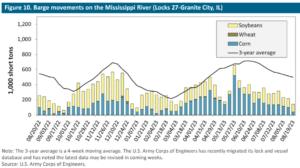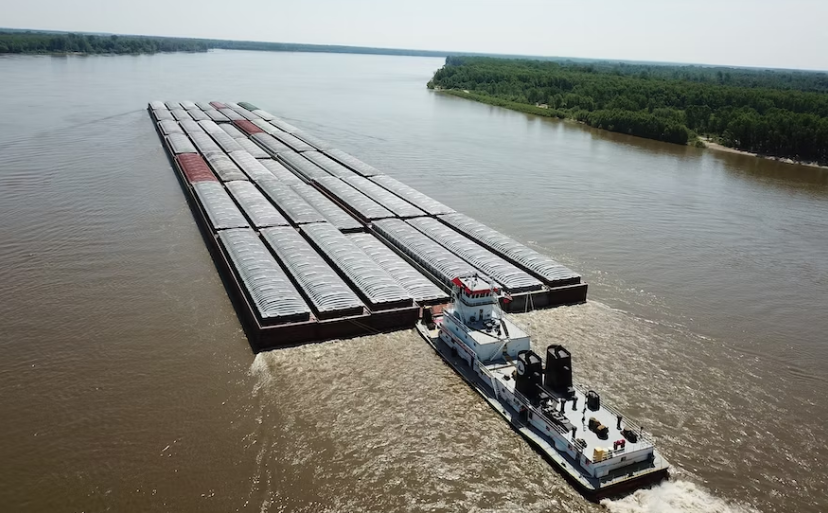Reliable Logistics: Barges Move U.S. Wheat Efficiently
According to the U.S. Department of Agriculture, approximately 31% of U.S. exported wheat is moved by barge to export points in the Gulf of Mexico and the Pacific Northwest (PNW). Barging is an extremely safe, efficient, and competitive mode of transporting grain for export, contributing to our robust grain marketing system.
As key gateways for wheat exports, this article will explore recent barge freight trends on the Mississippi River (photo above) and Colombia Snake River System (CSRS), highlighting their effectiveness and providing updates about current issues.

The Mississippi and the Columbia-Snake River systems are major transportation routes facilitating exports from the Gulf of Mexico and the PNW. Source: USDA/Agricultural Marketing Service/Transportation and Marketing Program/Transportation Economics Division.
Mississippi River Update
About 8% of all U.S. wheat moves on the Mississippi River system, bringing primarily soft red winter wheat (SRW) from growing regions in the eastern U.S. to export in the Gulf of Mexico via the Mississippi, Missouri, Illinois, and Ohio rivers. The Mississippi River system spans an immense geographic area, originating grain from as far north as Minnesota and as far east as Ohio and Illinois. Barges on the Mississippi River can carry 1,750 MT of grain, and a 15 barge tow can transport over 26,000 MT, the equivalent of 2 unit trains. Exports from the Gulf of Mexico account for 33% of U.S. wheat exports. Though wheat only accounts for 3% of Mississippi River barge movements, it is still an essential and efficient mode of transportation for U.S. wheat.
In the fall of 2022, low water levels on the lower Mississippi River slowed exports at ports on the Louisiana Gulf to their lowest level in 9 years. As a result, barge rates skyrocketed, and grain flows were restricted.

In October 2022, Mississippi River barge rates spiked to a record high of $2,092.83, 150% above the next highest price, due to low water levels and restricted barge flows Source: USDA Monthly Downbound Grain Barge Rates.
Since last fall, Mississippi River barge tariffs have normalized. However, according to the latest Grain Transportation Report, barge movements on the Mississippi River (Lock 27- Granite City, IL) are down 46% from last year and 72% below the three-year average. This decrease is attributed primarily to lower exports for all commodities (wheat, corn, and soybeans). Looking ahead, draft reductions in the lower Mississippi River may be a recurring issue as dryness in the Midwest persists.

Barge movements vary by season on the Mississippi River, but are down 46% from last year and 72% from the three-year average, driven primarily by a sharp decrease in grain exports. Weekly inspections for exported grain (wheat, corn, and soybeans) are down 47% from last year and 45% below the three-year average. Source: USDA Grain Transportation Report.
Columbia Snake River System
Shifting our focus to the PNW, the Columbia Snake River System (CSRS) accounts for 60% of all U.S. wheat exports via the deep-water draft ports on the Lower Columbia River. By barge alone, over 10% of all U.S. wheat exports move on the CSRS from as far inland as Lewiston, Idaho (360 miles). From an efficiency standpoint, according to the Pacific Northwest Waterway Association, barges on the CSRS can carry 3,500 MT of grain, and a four barge tow can transport over 14,000 MT, the equivalent of 1.5 unit trains and over 580 trucks.
From January 14 to March 29, 2024, an extended closure of the CSRS is scheduled to replace components at the John Day and McNary dams on the Columbia River and at the Lower Monumental, Little Goose, and Lower Granite dams on the Snake River. Routine maintenance assures the waterway remains a reliable mode of grain transportation and helps maintain the competitiveness of U.S. wheat. Similar to the Gulf of Mexico, grain exports from the PNW are down 71% from last year and 65% below the three-year average, subsequently impacting demand for barges.

Due to low export demand, grain exports from the PNW are down 71% from last year and 65% below the three-year average. Source: USDA FGIS Export Grain Inspections Data.
A Reliable System
U.S. Wheat Associates is committed to sharing transparent and pertinent information to customers about inland logistics issues, as domestic transportation makes up a significant portion of U.S. wheat export basis. Though barges only make up a small portion of U.S. inland logistics, barging helps ensure the U.S. remains the most reliable choice for world importers by complementing the use of Class I railroads and trucks. With diverse origination options and numerous modes of transportation, regardless of the class or export point, U.S. wheat is always available.
This is the first in a series of three articles about the efficient and reliable U.S. grain export transportation system. Future articles will focus on rail and ocean freight logistics.
By USW Market Analyst Tyllor Ledford.


